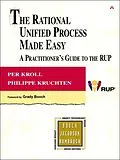"Per Kroll and Philippe Kruchten are especially well suited to explain the RUP...because they have been the central forces inside Rational Software behind the creation of the RUP and its delivery to projects around the world."
--From the Foreword by Grady Booch
This book is a comprehensive guide to modern software development practices, as embodied in the Rational Unified Process, or RUP. With the help of this book's practical advice and insight, software practitioners will learn how to tackle challenging development projects--small and large--using an iterative and risk-driven development approach with a proven track record.
The Rational Unified Process Made Easy will teach you the key points involved in planning and managing iterative projects, the fundamentals of component design and software architecture, and the proper employment of use cases. All team members--from project managers to analysts, from developers to testers--will learn how to immediately apply the RUP to their work. You will learn that the RUP is a flexible, versatile process framework that can be tailored to suit the needs of development projects of all types and sizes.
Key topics covered include:
- How to use the RUP to develop iteratively, adopt an architecture-centric approach, mitigate risk, and verify software quality
- Tasks associated with the four phases of the RUP: Inception, Elaboration, Construction, and Transition
- Roles and responsibilities of project managers, architects, analysts, developers, testers, and process engineers in a RUP project
- Incrementally adopting the RUP with minimal risk
- Common patterns for failure with the RUP--and how to avoid them
Use this book to get quickly up to speed with the RUP, so you can easily employ the significant power of this process to increase the productivity of your team.
Autorentext
Per Kroll manages the development of RUP and is responsible for IBM Rational process strategy. He launched and is the project lead for the open source process initiative Eclipse Process Framework (EPF). In addition to his highly acclaimed books, Per has written for a variety of trade magazines.
Philippe Kruchten is the lead architect of the Rational Unified Process. He has more than thirty years of experience in the development of large software-intensive systems for the telecommunications, defense, aerospace, and transportation industries. His book The Rational Unified Process: An Introduction (Addison-Wesley) has been translated into eight languages and has sold more than 160,000 copies in its two previous editions.
Inhalt
Figures. Tables. Foreword. Preface.
I. INTRODUCING THE RATIONAL UNIFIED PROCESS.
1. Introducing the Rational Unified Process.
What Is the Rational Unified Process?
The RUP-The Approach.
Underlying Principles of the RUP Approach.
The RUP and Iterative Development.
The RUP--A Well-Defined Software Engineering Process.
The Dynamic Structure of the Rational Unified Process.
The Static Structure of the Rational Unified Process.
The RUP-A Customizable Process Product.
Configuration and Process Authoring Tools.
Process Delivery Tools.
Who Uses the RUP Product?
Conclusion.
2. The Spirit of the RUP: Guidelines for Success.
Attack Major Risks Early and Continuously, or They Will Attack You.
Summary.
Ensure That You Deliver Value to Your Customer.
Summary.
Stay Focused on Executable Software.
Summary.
Accommodate Change Early in the Project.
Summary.
Baseline an Executable Architecture Early On.
Summary.
Build Your System with Components.
Summary.
Work Together as One Team.
Summary.
Make Quality a Way of Life, Not an Afterthought.
Summary.
Conclusion.
3. Comparing Processes: The RUP, Agile Methods, and Heavyweight Government Standards.
How Can We Compare Processes?
Agile Development: Low-Ceremony, Iterative Approaches.
SEI CMM, SEI CMMI, ISO/IEC, DOD-STD, MIL-STD: High Ceremony Striving for Higher Predictability.
SEI CMM: Process Assessment Framework.
SEI CMMI: Process Assessment Framework.
ISO/IEC 15504: Process Assessment Framework.
DOD-STD and MIL-STD: High-Ceremony Processes.
The RUP: An Iterative Approach with an Adaptable Level of Ceremony.
How Iterative Do You Want to Be?
How Much Ceremony Do You Want?
What Kind of RUP Configuration Meets Your Process Needs?
Project Deimos: Team of One.
Project Ganymede: Small Project with Tight Timeline.
Project Mars: Average-Size Project without Iterative Development Experience.
Project Jupiter: Large Distributed Project.
Conclusion.
4. The RUP for a Team of One: Project Deimos.
A Solo Software Project: Project Deimos.
The Seminal Idea (Saturday Night).
The Proposal (Monday Morning).
The Vision.
The Plan.
The Risk List.
The Business Case.
The Architecture.
The Commitment (Monday Lunch).
The Vision, Take Two.
The Plan, Take Two.
The Risk List, Take Two.
The Business Case, Take Two.
Digging In (Later Monday).
Pressing On (Tuesday).
More Progress, More Changes (Wednesday).
Nearing Completion (Thursday).
Beta and Ship (Friday).
Conclusion.
II. THE LIFECYCLE OF A RATIONAL UNIFIED PROCESS PROJECT.
5. Going Through the Four Phases.
A Major Misconception.
Major Milestones.
No Fixed Workflows.
No Frozen Artifacts.
Three Types of Projects.
6. The Inception Phase.
Objectives of the Inception Phase.
Inception and Iterations.
Objective 1: Understand What to Build.
Produce a Vision Document.
Generate a "Mile-Wide, Inch-Deep" Description.
Hold a Workshop or Brainstorming Session.
Detail Key Actors and Use …
